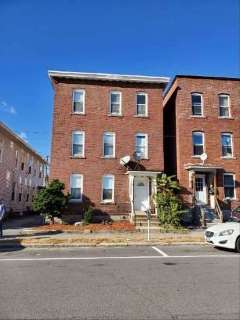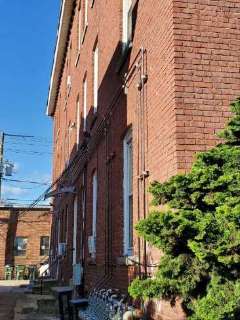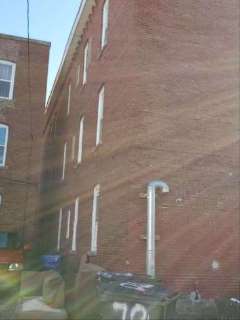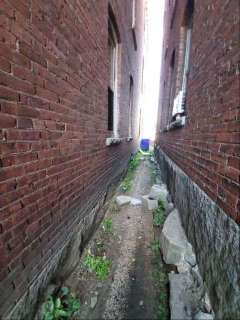Millyard Home Inspection
Inspector: Daniel Lombardo




Summary
| Client(s): | TBD Realty LLC |
| Property address: | 66-68 Orange St Manchester, NH |
| Inspection date: | Friday, October 4, 2019 |
This report published on Saturday, October 5, 2019 8:35:11 PM EDT
This report is the exclusive property of this inspection company and the client(s) listed in the report title. Use of this report by any unauthorized persons is prohibited.
| Safety | Poses a safety hazard | |
| Repair/Replace | Recommend repairing or replacing | |
| Repair/Maintain | Recommend repair and/or maintenance | |
| Minor Defect | Correction likely involves only a minor expense | |
| Evaluate | Recommend evaluation by a specialist | |
| Monitor | Recommend monitoring in the future | |
| Comment | For your information |
General Information
1) 
 Tennants should be made aware thst keeping entry areas/doorways free and clear of furnishing and stored items.
Tennants should be made aware thst keeping entry areas/doorways free and clear of furnishing and stored items.
Many areas and items at this property were obscured by furniture and/or stored items. This often includes but is not limited to walls, floors, windows, inside and under cabinets, under sinks, on counter tops, in closets, behind window coverings, under rugs or carpets, and under or behind furniture. Areas around the exterior, under the structure, in the garage and in the attic may also be obscured by stored items. The inspector in general does not move personal belongings, furnishings, carpets or appliances. When furnishings, stored items or debris are present, all areas or items that are obscured, concealed or not readily accessible are excluded from the inspection. The client should be aware that when furnishings, stored items or debris are eventually moved, damage or problems that were not noted during the inspection may be found.
Many areas and items at this property were obscured by furniture and/or stored items. This often includes but is not limited to walls, floors, windows, inside and under cabinets, under sinks, on counter tops, in closets, behind window coverings, under rugs or carpets, and under or behind furniture. Areas around the exterior, under the structure, in the garage and in the attic may also be obscured by stored items. The inspector in general does not move personal belongings, furnishings, carpets or appliances. When furnishings, stored items or debris are present, all areas or items that are obscured, concealed or not readily accessible are excluded from the inspection. The client should be aware that when furnishings, stored items or debris are eventually moved, damage or problems that were not noted during the inspection may be found.
2) 
 Structures built prior to the mid 1980s may contain lead and/or asbestos. Lead is commonly found in paint and in some plumbing components. The EPA does not recognize newer coats of paint as encapsulating older coats of lead-based paint. Asbestos is commonly found in various building materials such as insulation, siding, and/or floor and ceiling tiles. Laws were passed in 1978 to prohibit usage of lead and asbestos, but stocks of materials containing these substances remained in use for a number of years thereafter. Both lead and asbestos are known health hazards. Evaluating for the presence of lead and/or asbestos is beyond the scope of this inspection. Any mention of these materials in this report is made as a courtesy only, and meant to refer the client to a specialist. Consult with specialists as necessary, such as industrial hygienists, professional labs and/or abatement specialists for this type of evaluation. For information on lead, asbestos and other hazardous materials in homes, visit:
Structures built prior to the mid 1980s may contain lead and/or asbestos. Lead is commonly found in paint and in some plumbing components. The EPA does not recognize newer coats of paint as encapsulating older coats of lead-based paint. Asbestos is commonly found in various building materials such as insulation, siding, and/or floor and ceiling tiles. Laws were passed in 1978 to prohibit usage of lead and asbestos, but stocks of materials containing these substances remained in use for a number of years thereafter. Both lead and asbestos are known health hazards. Evaluating for the presence of lead and/or asbestos is beyond the scope of this inspection. Any mention of these materials in this report is made as a courtesy only, and meant to refer the client to a specialist. Consult with specialists as necessary, such as industrial hygienists, professional labs and/or abatement specialists for this type of evaluation. For information on lead, asbestos and other hazardous materials in homes, visit:
https://www.reporthost.com/?EPA
https://www.reporthost.com/?CPSC
https://www.reporthost.com/?CDC
https://www.reporthost.com/?EPA
https://www.reporthost.com/?CPSC
https://www.reporthost.com/?CDC
Grounds
4) 
 Side entry stairs (concrete) were in need of repair. Trip/fall hazard. Recommend evaluation and repair by a qualified contractor to repair.
Side entry stairs (concrete) were in need of repair. Trip/fall hazard. Recommend evaluation and repair by a qualified contractor to repair.
Exterior and Foundation
6) 
 Moderate cracks (1/8 inch - 3/4 inch) and/or leaning were found in the foundation. This may be a structural concern or an indication that settlement is ongoing. The client should consider hiring qualified contractors and/or engineers as necessary for further evaluation. Such contractors may include:
Moderate cracks (1/8 inch - 3/4 inch) and/or leaning were found in the foundation. This may be a structural concern or an indication that settlement is ongoing. The client should consider hiring qualified contractors and/or engineers as necessary for further evaluation. Such contractors may include:
- Foundation repair contractors who may prescribe repairs, and will give cost estimates for such repairs
- Masonry contractors who repair and/or replace brick veneer
- Geotechnical engineers who attempt to determine if settlement is ongoing, and the cause of the settlement
- Structural engineers who determine if repairs are necessary, and prescribe those repairs
7)  Front window first floor ( frame was in need of repair.) Vinyl damaged.
Front window first floor ( frame was in need of repair.) Vinyl damaged.
Basement
8) 
 The only entrance/exit to the basement appeared to be the basement stairs. While this is common in older homes, modern standards require a secondary escape for use in the event of fire or an emergency. Such entrances/exits should allow entry by emergency personnel and their equipment. It is beyond the scope of this inspection to verify compliance with the current codes, and codes are generally not retroactive. Consult with a window/door contractor and/or the local municipal building officials regarding egress guidelines.
The only entrance/exit to the basement appeared to be the basement stairs. While this is common in older homes, modern standards require a secondary escape for use in the event of fire or an emergency. Such entrances/exits should allow entry by emergency personnel and their equipment. It is beyond the scope of this inspection to verify compliance with the current codes, and codes are generally not retroactive. Consult with a window/door contractor and/or the local municipal building officials regarding egress guidelines.
9)  No under-floor insulation was installed in the unheated basement. Recommend that a qualified person install insulation for better energy efficiency and per standard building practices. Typically this is R-19 rated fiberglass batt with the attached facing installed against the warm (floor) side.
No under-floor insulation was installed in the unheated basement. Recommend that a qualified person install insulation for better energy efficiency and per standard building practices. Typically this is R-19 rated fiberglass batt with the attached facing installed against the warm (floor) side.
10) 
 Dirt floor portions of basement should have vapor barrier/plastic installed to prevent moisture from wicking into wood components in basement ceiling. Recommend evaluation and installation by a qualified contractor. This is a conductive condition for insect infestation and rot damage.
Dirt floor portions of basement should have vapor barrier/plastic installed to prevent moisture from wicking into wood components in basement ceiling. Recommend evaluation and installation by a qualified contractor. This is a conductive condition for insect infestation and rot damage.
Electric
11) 
 One or more modern, 3-slot electric receptacles were found with an open ground. This is a shock hazard when appliances that require a ground are used with these receptacles. Examples of such appliances include computers and related hardware, refrigerators, freezers, portable air conditioners, clothes washers, aquarium pumps, and electrically operated gardening tools. Recommend that a qualified electrician repair as necessary so all receptacles are grounded per standard building practices.
One or more modern, 3-slot electric receptacles were found with an open ground. This is a shock hazard when appliances that require a ground are used with these receptacles. Examples of such appliances include computers and related hardware, refrigerators, freezers, portable air conditioners, clothes washers, aquarium pumps, and electrically operated gardening tools. Recommend that a qualified electrician repair as necessary so all receptacles are grounded per standard building practices.
12) 
 Light in halls could only be turned on/off on upper floors by accessing individual apartments.
Light in halls could only be turned on/off on upper floors by accessing individual apartments.
The light fixture at one or more sets of stairs with living spaces at both ends was controlled by a single switch at one end. This is a safety hazard due to inadequate lighting. The light should be controlled by 3-way switches at the top and bottom of the stairs so it can be easily operated on both floors. Recommend that a qualified electrician repair per standard building practices.
The light fixture at one or more sets of stairs with living spaces at both ends was controlled by a single switch at one end. This is a safety hazard due to inadequate lighting. The light should be controlled by 3-way switches at the top and bottom of the stairs so it can be easily operated on both floors. Recommend that a qualified electrician repair per standard building practices.
Plumbing / Fuel Systems
13) 
 In Old laundry area located in basement (ceiling)
In Old laundry area located in basement (ceiling)
One or more leaks were found in water supply pipes or fittings. A qualified plumber should evaluate and repair as necessary.
One or more leaks were found in water supply pipes or fittings. A qualified plumber should evaluate and repair as necessary.
14) 
 Significant corrosion was found in some water supply pipes or fittings. Leaks can occur as a result. Recommend that a qualified plumber evaluate and replace components as necessary.
Significant corrosion was found in some water supply pipes or fittings. Leaks can occur as a result. Recommend that a qualified plumber evaluate and replace components as necessary.
Water Heater
15)  The hot water temperature was greater than 120 degrees Fahrenheit. This is a safety hazard due to the risk of scalding. The thermostat should be adjusted so the water temperature doesn't exceed 120 degrees. If the water heater is powered by electricity, a qualified person should perform the adjustment, since covers that expose energized equipment normally need to be removed. For more information on scalding dangers, visit:
The hot water temperature was greater than 120 degrees Fahrenheit. This is a safety hazard due to the risk of scalding. The thermostat should be adjusted so the water temperature doesn't exceed 120 degrees. If the water heater is powered by electricity, a qualified person should perform the adjustment, since covers that expose energized equipment normally need to be removed. For more information on scalding dangers, visit:
https://www.reporthost.com/?SCALD
https://www.reporthost.com/?SCALD
Heating, Ventilation and Air Condition (HVAC)
17) 
 No drain line was installed for the boiler's temperature-pressure relief valve. This is a potential safety hazard due to the risk of scalding if someone is standing next to the boiler when the valve opens. Recommend that a qualified heating contractor or plumber install a drain line per standard building practices.
No drain line was installed for the boiler's temperature-pressure relief valve. This is a potential safety hazard due to the risk of scalding if someone is standing next to the boiler when the valve opens. Recommend that a qualified heating contractor or plumber install a drain line per standard building practices.
18) 

 The barometric draft damper for the boiler and/or for water tank was back drafting. This may result in improper drafting and is a potential safety hazard. Recommend that a qualified heating contractor evaluate and repair as necessary.
The barometric draft damper for the boiler and/or for water tank was back drafting. This may result in improper drafting and is a potential safety hazard. Recommend that a qualified heating contractor evaluate and repair as necessary.
19) 
 Recommend servicing of natural gas boilers located in basement. See concerns in regard to missing TPR drainlines.
Recommend servicing of natural gas boilers located in basement. See concerns in regard to missing TPR drainlines.
The furnace for the water tank (Super Stor) had a missing back flow drainline line. Also the TPR drainline for this furnace had a threaded end. This is a safety concern in regard to someone being able to cap and block drainlinline with threaded cap.
The furnace was installed in 2016 however the unit may be as old as 12 years old from serial number.
The furnace for the water tank (Super Stor) had a missing back flow drainline line. Also the TPR drainline for this furnace had a threaded end. This is a safety concern in regard to someone being able to cap and block drainlinline with threaded cap.
The furnace was installed in 2016 however the unit may be as old as 12 years old from serial number.
20) 
 apartment units with individual direct vent gas heaters had vents installed in walls to distribute heat to bedrooms. No heat available in bathrooms.
apartment units with individual direct vent gas heaters had vents installed in walls to distribute heat to bedrooms. No heat available in bathrooms.
One or more "livable" rooms had no visible source of heat. Examples of livable rooms include bedrooms, kitchens and living/dining rooms, NOT hallways, closets or bathrooms. Livable rooms without heat (e.g. heat register, radiator, baseboard or wall heater) can be uncomfortable and have high levels of moisture. Depending on the client's needs, recommend consulting with a qualified heating contractor to determine options for modifying or improving the heating system per standard building practices.
One or more "livable" rooms had no visible source of heat. Examples of livable rooms include bedrooms, kitchens and living/dining rooms, NOT hallways, closets or bathrooms. Livable rooms without heat (e.g. heat register, radiator, baseboard or wall heater) can be uncomfortable and have high levels of moisture. Depending on the client's needs, recommend consulting with a qualified heating contractor to determine options for modifying or improving the heating system per standard building practices.
Fireplaces, Stoves, Chimneys and Flues
22) 
 No spark screen or rain cap was installed at one or more chimney flue terminations. Spark screens reduce the chance of embers exiting the flue and causing fires. They also prevent wildlife (e.g. birds, rodents, raccoons) from entering flues. Rain caps prevent water from entering flues, mixing with combustion deposits and creating caustic chemicals which can corrode flues. They also prevent damage to masonry from freeze-thaw cycles and prevent metal components (e.g. dampers, metal firebox liners) from rusting. Recommend that a qualified person install rain caps with spark screens per standard building practices where missing.
No spark screen or rain cap was installed at one or more chimney flue terminations. Spark screens reduce the chance of embers exiting the flue and causing fires. They also prevent wildlife (e.g. birds, rodents, raccoons) from entering flues. Rain caps prevent water from entering flues, mixing with combustion deposits and creating caustic chemicals which can corrode flues. They also prevent damage to masonry from freeze-thaw cycles and prevent metal components (e.g. dampers, metal firebox liners) from rusting. Recommend that a qualified person install rain caps with spark screens per standard building practices where missing.
Kitchen
23) 
 The exhaust fan over the range recirculated the exhaust air back into the kitchen. This may be due to no duct being installed, baffles not being installed, or problems with duct work. This can be a nuisance for odor and grease accumulation. Where a gas-fired range or cook top is installed, carbon monoxide and excessive levels of moisture can accumulate in living spaces. Recommend that a qualified contractor evaluate and repair as necessary so exhaust air is ducted outdoors.
The exhaust fan over the range recirculated the exhaust air back into the kitchen. This may be due to no duct being installed, baffles not being installed, or problems with duct work. This can be a nuisance for odor and grease accumulation. Where a gas-fired range or cook top is installed, carbon monoxide and excessive levels of moisture can accumulate in living spaces. Recommend that a qualified contractor evaluate and repair as necessary so exhaust air is ducted outdoors.
24)  No exhaust hood, ceiling or wall-mounted exhaust fan or downdraft exhaust system was found for the cook top or range. This can be a nuisance for odor and grease accumulation. Where a gas-fired range or cook top is installed, carbon monoxide and excessive levels of moisture can accumulate in living spaces. Recommend that a qualified contractor install a venting system per standard building practices.
No exhaust hood, ceiling or wall-mounted exhaust fan or downdraft exhaust system was found for the cook top or range. This can be a nuisance for odor and grease accumulation. Where a gas-fired range or cook top is installed, carbon monoxide and excessive levels of moisture can accumulate in living spaces. Recommend that a qualified contractor install a venting system per standard building practices.
25)  Gaps, no caulk, or substandard caulking were found between countertops and backsplashes and/or around the sink. Water may penetrate these areas and cause damage. Recommend that a qualified person repair as necessary. For example, by installing caulk.
Gaps, no caulk, or substandard caulking were found between countertops and backsplashes and/or around the sink. Water may penetrate these areas and cause damage. Recommend that a qualified person repair as necessary. For example, by installing caulk.
26)  In regard to second floor 1br rear unit:
In regard to second floor 1br rear unit:
Water was leaking at the sink faucet base or handles. Recommend that a qualified plumber repair as necessary.
Water was leaking at the sink faucet base or handles. Recommend that a qualified plumber repair as necessary.
Bathrooms, Laundry and Sinks
27)  The bathroom with a shower or bathtub at location(s) #In all units didn't have an exhaust fan installed. Moisture can accumulate and result in mold, bacteria or fungal growth. Even if the bathroom has a window that opens, it may not provide adequate ventilation, especially during cold weather when windows are closed or when wind blows air into the bathroom. Recommend that a qualified contractor install exhaust fans per standard building practices where missing in bathrooms with showers or bathtubs.
The bathroom with a shower or bathtub at location(s) #In all units didn't have an exhaust fan installed. Moisture can accumulate and result in mold, bacteria or fungal growth. Even if the bathroom has a window that opens, it may not provide adequate ventilation, especially during cold weather when windows are closed or when wind blows air into the bathroom. Recommend that a qualified contractor install exhaust fans per standard building practices where missing in bathrooms with showers or bathtubs.
28)  Tile, stone and/or grout in the flooring at location(s) #3rd floor 1 br was deteriorated (e.g. loose or cracked tiles, missing grout) or substandard. Water can damage the sub-floor as a result. Recommend that a qualified contractor repair as necessary.
Tile, stone and/or grout in the flooring at location(s) #3rd floor 1 br was deteriorated (e.g. loose or cracked tiles, missing grout) or substandard. Water can damage the sub-floor as a result. Recommend that a qualified contractor repair as necessary.
29)  Gaps, no caulk, or substandard caulking were found between the bathtub and the floor and/or walls at location(s) #all bathrooms. Water may penetrate these areas and cause damage. Recommend that a qualified person re-caulk or install caulking as necessary.
Gaps, no caulk, or substandard caulking were found between the bathtub and the floor and/or walls at location(s) #all bathrooms. Water may penetrate these areas and cause damage. Recommend that a qualified person re-caulk or install caulking as necessary.
Caulk was deteriorating at tub/ walls and tub/floors water damage to subfloor cannot be determined or extent of damage in unseen areas to bathroom floors.
Client should be aware that tenants may not be paying attention to water damage in these areas. Monitor bathroom floors and walls for water damage.
Caulk was deteriorating at tub/ walls and tub/floors water damage to subfloor cannot be determined or extent of damage in unseen areas to bathroom floors.
Client should be aware that tenants may not be paying attention to water damage in these areas. Monitor bathroom floors and walls for water damage.
30)  The shower head at location(s) #3rd floor/1br east unit was dripping when the shower was turned off. Recommend that a qualified person repair as necessary.
The shower head at location(s) #3rd floor/1br east unit was dripping when the shower was turned off. Recommend that a qualified person repair as necessary.
Interior, Doors and Windows
31) 
 Handrails at one or more flights of stairs were loose. This is a safety hazard. Recommend that a qualified person repair as necessary.
Handrails at one or more flights of stairs were loose. This is a safety hazard. Recommend that a qualified person repair as necessary.
Front hall entry
Front hall entry
32) 
 Screens were missing from some windows. These windows may not provide ventilation during months when insects are active.
Screens were missing from some windows. These windows may not provide ventilation during months when insects are active.
33)  Glass in one or more windows was cracked, broken and/or missing. Recommend that a qualified contractor replace glass where necessary.
Glass in one or more windows was cracked, broken and/or missing. Recommend that a qualified contractor replace glass where necessary.
Second floor hall
Second floor hall
34)  Vinyl floor tiles were installed in one or more "wet" areas (e.g. kitchen, mud room, bathroom, laundry room). Spilled water can penetrate seams and damage the sub-floor. Recommend that a qualified contractor install continuous waterproof flooring in wet areas as necessary.
Vinyl floor tiles were installed in one or more "wet" areas (e.g. kitchen, mud room, bathroom, laundry room). Spilled water can penetrate seams and damage the sub-floor. Recommend that a qualified contractor install continuous waterproof flooring in wet areas as necessary.
35)  Many interior doors through out interior of building:
Many interior doors through out interior of building:
One or more interior doors were sticking in the door jamb and were difficult to operate. Recommend that a qualified person repair as necessary. For example, by trimming doors.
One or more interior doors were sticking in the door jamb and were difficult to operate. Recommend that a qualified person repair as necessary. For example, by trimming doors.
36)  Minor cracks, nail pops and/or blemishes were found in walls and/or ceilings in one or more areas. Cracks and nail pops are common, are often caused by lumber shrinkage or minor settlement, and can be more or less noticeable depending on changes in humidity. They did not appear to be a structural concern, but the client may wish to repair these for aesthetic reasons. For recurring cracks, consider using an elastic crack covering product:
Minor cracks, nail pops and/or blemishes were found in walls and/or ceilings in one or more areas. Cracks and nail pops are common, are often caused by lumber shrinkage or minor settlement, and can be more or less noticeable depending on changes in humidity. They did not appear to be a structural concern, but the client may wish to repair these for aesthetic reasons. For recurring cracks, consider using an elastic crack covering product:
https://www.reporthost.com/?ECC
https://www.reporthost.com/?ECC
